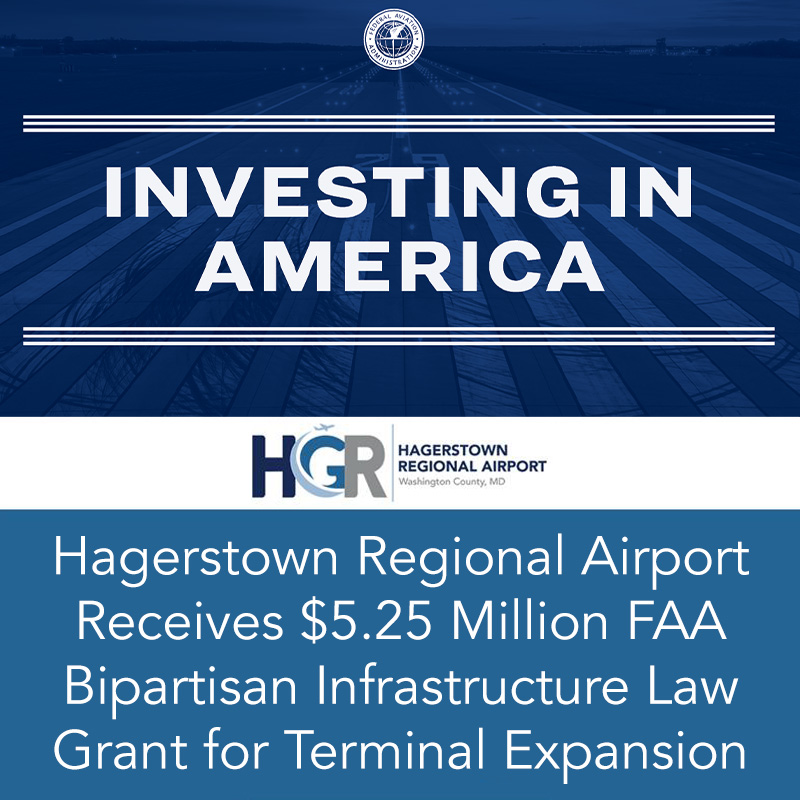Hagerstown Regional Airport Receives $5.25 Million FAA Bipartisan Infrastructure Law Grant for Terminal Expansion – Washington County Government

Hagerstown Regional Airport Receives $5.25 Million Grant for Terminal Expansion

HAGERSTOWN, MD (October 24, 2024) – Hagerstown Regional Airport (HGR) is proud to announce that it has been awarded a $5.25 million dollar grant from the Federal Aviation Administration (FAA) under the Bipartisan Infrastructure Law (BIL). This competitive national grant will enable the airport to expand its terminal by no less than 20%, a significant step in accommodating future growth and enhancing operations for air carriers and passengers.
Grant Supports Sustainable Development Goals
- Goal 9: Industry, Innovation, and Infrastructure
- Goal 11: Sustainable Cities and Communities
“This grant is a testament to the future potential of Hagerstown Regional Airport,” said Neil Doran, Airport Director at HGR. “Receiving a larger award than many higher-volume airports highlights the FAA’s confidence in our growth trajectory and the need for additional space to support our continued expansion. This project will encourage more competition among the airlines by constructing the terminal support spaces necessary for additional airlines to more realistically and feasibly serve HGR in the future.”
Ninety-five percent (95%) of this expansion project will be funded by the federal government, with HGR likely also utilizing additional entitlement funds to fully support the improvements if costs exceed $5.25 million. The Maryland Aviation Administration has also signaled their support to fund a portion of the costs of this project.
This critical infrastructure project will enhance operational efficiency and provide the necessary space to support both the current airline and any potential future air carriers, positioning HGR for long-term success. The expansion will focus on the terminal’s east side, adding more ticketing counters, expanded passenger queuing areas, and additional space for leasable concessionaire counters. Additionally, behind-the-scenes areas that are not typically visible to passengers will be expanded to better accommodate the space needs of airlines, their personnel, and essential equipment.
“We’re excited about this opportunity to better serve our community and travelers,” added Andrew Eshleman, Public Works Director, “and we’re grateful for the FAA’s support through this competitive grant process.”
We are proud to be a recipient of the FAA’s $5.25 million-dollar Bipartisan Infrastructure Law grant award. This investment will go towards projects that improve and enhance the passenger experience by expanding terminal space to better accommodate our current and future growth.
Learn more about how these historic investments are improving airports nationwide by visiting www.faa.gov/bil.
About Hagerstown Regional Airport (HGR)
Hagerstown Regional Airport is committed to providing high-quality, efficient air travel services to the local community and beyond. With a growing number of operations and carriers, HGR continues to expand its services and facilities to meet the evolving needs of its passengers.
For more information, please call 240-313-2777.
SDGs, Targets, and Indicators
1. Which SDGs are addressed or connected to the issues highlighted in the article?
- SDG 9: Industry, Innovation, and Infrastructure
- SDG 11: Sustainable Cities and Communities
The article discusses the expansion of Hagerstown Regional Airport’s terminal, which is related to the development of infrastructure and the improvement of transportation services in the region. This aligns with SDG 9, which focuses on promoting sustainable industrialization, fostering innovation, and upgrading infrastructure. Additionally, the expansion project aims to enhance operational efficiency and accommodate future growth, contributing to the goal of creating sustainable cities and communities (SDG 11).
2. What specific targets under those SDGs can be identified based on the article’s content?
- SDG 9.1: Develop quality, reliable, sustainable, and resilient infrastructure
- SDG 9.2: Promote inclusive and sustainable industrialization
- SDG 11.2: Provide access to safe, affordable, accessible, and sustainable transport systems
- SDG 11.3: Enhance inclusive and sustainable urbanization
The expansion of the airport’s terminal aligns with SDG 9.1 as it aims to develop quality and reliable infrastructure to support air travel services. It also contributes to SDG 9.2 by promoting sustainable industrialization in the aviation sector. Furthermore, the project supports SDG 11.2 by providing improved access to safe and sustainable transport systems. Lastly, the expansion project contributes to SDG 11.3 by enhancing the urbanization process in the region through the development of airport facilities.
3. Are there any indicators mentioned or implied in the article that can be used to measure progress towards the identified targets?
- Percentage increase in terminal size
- Number of additional ticketing counters
- Expansion of passenger queuing areas
- Increase in leasable concessionaire counters
The article mentions that the expansion project will increase the terminal’s size by at least 20%. This can be used as an indicator to measure progress towards SDG 9.1. Additionally, the article mentions the addition of more ticketing counters, expanded passenger queuing areas, and additional space for leasable concessionaire counters. These can serve as indicators to measure progress towards SDG 11.2 and SDG 11.3, as they contribute to the improvement of transport services and the enhancement of urbanization.
SDGs, Targets, and Indicators
| SDGs | Targets | Indicators |
|---|---|---|
| SDG 9: Industry, Innovation, and Infrastructure | 9.1 Develop quality, reliable, sustainable, and resilient infrastructure | – Percentage increase in terminal size |
| 9.2 Promote inclusive and sustainable industrialization | – Number of additional ticketing counters – Expansion of passenger queuing areas – Increase in leasable concessionaire counters |
|
| SDG 11: Sustainable Cities and Communities | 11.2 Provide access to safe, affordable, accessible, and sustainable transport systems | – Number of additional ticketing counters – Expansion of passenger queuing areas |
| 11.3 Enhance inclusive and sustainable urbanization | – Increase in leasable concessionaire counters |
Source: washco-md.net








